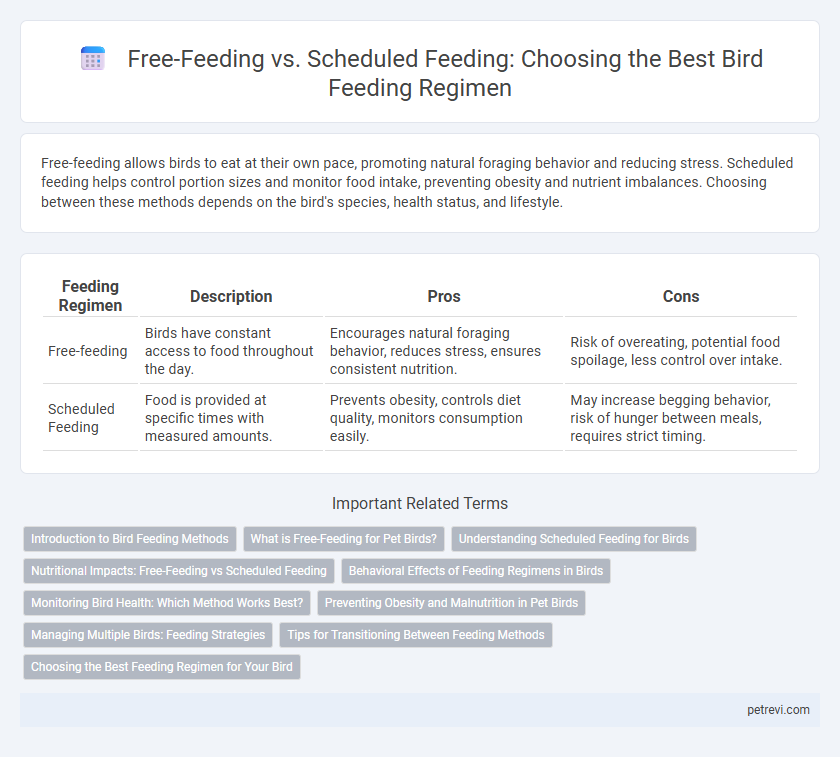Free-feeding allows birds to eat at their own pace, promoting natural foraging behavior and reducing stress. Scheduled feeding helps control portion sizes and monitor food intake, preventing obesity and nutrient imbalances. Choosing between these methods depends on the bird's species, health status, and lifestyle.
Table of Comparison
| Feeding Regimen | Description | Pros | Cons |
|---|---|---|---|
| Free-feeding | Birds have constant access to food throughout the day. | Encourages natural foraging behavior, reduces stress, ensures consistent nutrition. | Risk of overeating, potential food spoilage, less control over intake. |
| Scheduled Feeding | Food is provided at specific times with measured amounts. | Prevents obesity, controls diet quality, monitors consumption easily. | May increase begging behavior, risk of hunger between meals, requires strict timing. |
Introduction to Bird Feeding Methods
Free-feeding allows birds continuous access to food, promoting natural foraging behaviors and supporting stable energy levels throughout the day. Scheduled feeding involves providing food at specific times, which can help regulate intake and monitor consumption for health management. Both methods impact bird activity patterns and nutritional balance, making the choice critical for effective avian care.
What is Free-Feeding for Pet Birds?
Free-feeding for pet birds involves providing constant access to food throughout the day, allowing birds to eat at their own pace. This method supports natural foraging behavior but requires close monitoring to prevent overeating and obesity. Ensuring a balanced diet with fresh seeds, pellets, and fruits is essential to maintain optimal health in free-fed birds.
Understanding Scheduled Feeding for Birds
Scheduled feeding for birds involves providing meals at specific times, which helps regulate their metabolism and prevents overeating. This method supports healthier weight management and encourages natural foraging behaviors, promoting mental stimulation. Consistent feeding routines also make it easier to monitor a bird's overall health and detect any changes in appetite or behavior early on.
Nutritional Impacts: Free-Feeding vs Scheduled Feeding
Free-feeding can lead to overconsumption and obesity in birds due to constant access to food, potentially causing nutritional imbalances and health issues. Scheduled feeding promotes controlled nutrient intake, aiding in maintaining optimal body weight and preventing metabolic disorders. Birds on a regulated feeding schedule often exhibit more stable digestive rhythms and improved nutrient absorption efficiency.
Behavioral Effects of Feeding Regimens in Birds
Free-feeding in birds often leads to increased foraging behavior and a reduction in stress-related activities, promoting natural behavioral patterns. Scheduled feeding can enhance conditioned responses and improve cognitive engagement by creating predictable feeding times that stimulate anticipation and activity. Variations in feeding regimens directly influence bird welfare through their effects on activity levels, anxiety, and social interactions.
Monitoring Bird Health: Which Method Works Best?
Scheduled feeding allows precise monitoring of a bird's food intake, making it easier to detect changes in appetite that may signal health issues. Free-feeding can lead to overeating and obesity, complicating the assessment of a bird's nutritional status and overall well-being. For optimal health monitoring, scheduled feeding provides a controlled environment to track dietary habits and identify potential problems early.
Preventing Obesity and Malnutrition in Pet Birds
Free-feeding birds can lead to overeating and obesity, as constant access to food reduces their natural feeding control, increasing the risk of malnutrition due to selective eating. Scheduled feeding provides portion control and encourages physical activity, promoting a balanced diet and preventing obesity in pet birds. Implementing a consistent feeding routine supports better weight management and overall health in pet birds.
Managing Multiple Birds: Feeding Strategies
Managing multiple birds efficiently requires balancing free-feeding and scheduled feeding to prevent overeating and ensure balanced nutrition. Scheduled feeding allows precise control over portion sizes and dietary variety, reducing aggression and competition among birds. Free-feeding may be suitable for less aggressive species but demands constant monitoring to avoid food wastage and obesity.
Tips for Transitioning Between Feeding Methods
Gradually mix scheduled feeding times with free-feeding to help your bird adjust without stress. Monitor your bird's eating habits closely during the transition to ensure it maintains proper nutrition and weight. Consistency in feeding schedules combined with positive reinforcement encourages a smooth shift between free-feeding and scheduled feeding methods.
Choosing the Best Feeding Regimen for Your Bird
Free-feeding allows birds unlimited access to food throughout the day, promoting natural foraging behaviors but risking overeating and obesity. Scheduled feeding provides controlled portions at set times, supporting weight management and routine but may require more attention to ensure nutritional needs are met. Choosing the best feeding regimen depends on your bird's species, activity level, and health status to balance diet control with behavioral enrichment.
Free-feeding vs Scheduled feeding for Bird feeding regimen Infographic

 petrevi.com
petrevi.com